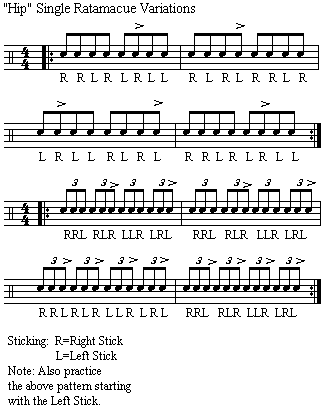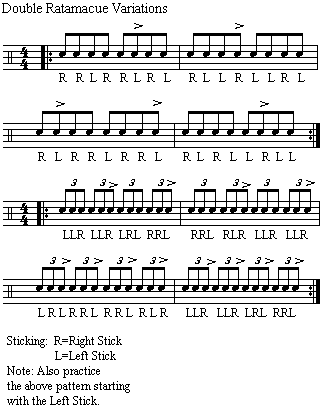Rudiments Around the Drums: Part 4
Not For Marching Only!
In my prior articles on Rudiments Around the Drums (See the Related Links sidebar), I covered Single Stroke Roll, Double Stroke Roll, Single and Double Paradiddle, Flam and Flam Tap, and Five- through Fifteen-Stroke Rolls. This week, I get creative with Ratamacues.
Open or Closed
To be sure we're all on the same page, let's take a look at the standard Single Ratamacue, which is one of the
standard Rudiments.

Above is the standard notation for the Single Ratamacue but there are actually two ways to play the grace notes. Grace notes are the 2 small notes preceding the eighth-note triplet. If you're not familiar with grace notes or need a refresher, see Tiger Reading 102.
In the Drum Corps style of playing, the grace notes are played as written, two distinct notes. In Orchestra or Jazz drumming, however, the grace notes are usually played closed, as a short buzz sound. Either way you interpret the grace notes, you can spread the Single Ratamacue around the drums in a variety of ways: play it as is on a Snare or Tom, break it up and play the grace notes on the snare and the remaining notes on a Tom or vice versa. You can also get some good sounds by playing the Single Ratamacue with one stick on the Ride Cymbal and the other on a Snare or Tom.
Hip Ratamacues
Another way to spread Ratamacues around the set is to change the time value of the grace notes, giving them
the same time value as the other notes in the Ratamacue. Take a look at the examples that follow.

Practice Ideas
As you can see, the Single Ratamacue now has the same sticking as an inverted Double Paradiddle. The first
exercise gives you the Single Ratamacue sticking over 4 bars of eighth-notes, while the second gives you the
Single Ratamacue sticking over 4 bars of eighth-note triplets. Practice the above patterns in these ways:
- On a Snare Drum or Tom, as written.
- Play all accented notes on your Toms and all unaccented notes on your Snare Drum.
- Play all unaccented notes with the written sticking and all accented notes with your Kick Drum foot.
- Same as #3 but add a Hi-Hat splash with your left foot on accented notes.
- Make 4 bars fills out of these by playing 4 bars of time between each 4 bar phrase.
- ? Create your own variation.
If you don't understand the term "4 bars of time" in number 5 above, what I mean is that you should pick a cymbal pattern and play it for 4 bars before playing the written exercise, then go back to the cymbal pattern and then back to the exercise again. This simulates what's called trading fours. Note: You can play straight Rock "time" for the first eighth-note Ratamacue example above, and Jazz "time" for the eighth-note triplet exercise.
Double Ratamacue
Before we get fancy, let's take a look at the standard Double Ratamacue.

Like with the Single Ratamacue on the previous page, there are two ways to play the grace notes. In the Drum Corps style of playing, the grace notes are played as two distinct notes. In Orchestra or Jazz drumming, however, the grace notes are usually played as a short buzz. Either way you interpret the grace notes, you can play the Double Ratamacue around the drums in many ways: As is on a snare or tom, break it up and play the grace notes on the snare and the remaining notes on a tom or vice versa. You can also try playing the Double Ratamacue with one stick on the Ride Cymbal and the other on a Snare or Tom.

Practice Ideas
Once you are comfortable playing each of the above examples as written, apply them to the entire Drum Kit as
follows:
- On a Snare Drum or Tom, as written.
- Play all accented notes on your Toms and all unaccented notes on your Snare Drum.
- Play all unaccented notes with the written sticking and all accented notes with your Kick Drum foot.
- Same as #3 but add a Hi-Hat splash with your left foot on accented notes.
- Make 4 bars fills out of these by playing 4 bars of time between each 4 bar phrase.
- ? Create your own variation.
That's it for now. In the fifth and final lesson in Rudiments Around the drums, we'll complete the Ratamacues and give you some ideas for combining the various Rudiments.
Until then: Stay loose.
Click the link for Rudiments Around the Drums: Part 5
